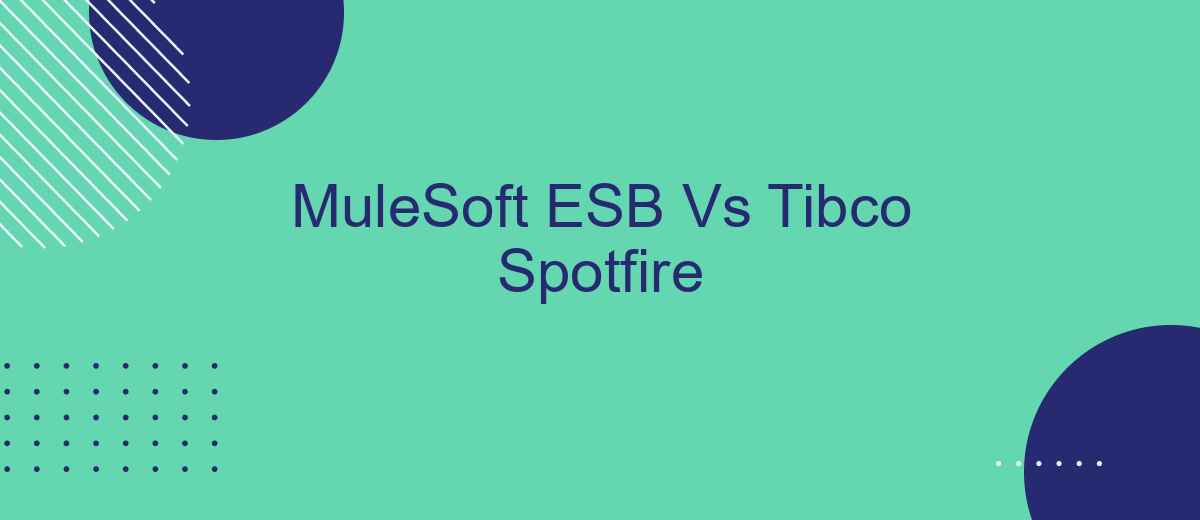In the rapidly evolving landscape of enterprise integration and business intelligence, choosing the right tools is crucial for success. This article delves into a detailed comparison between MuleSoft ESB, a leading integration platform, and Tibco Spotfire, a powerful analytics and business intelligence solution. By examining their features, capabilities, and use cases, we aim to help businesses make informed decisions tailored to their specific needs.
MuleSoft ESB Overview
MuleSoft ESB (Enterprise Service Bus) is a powerful integration platform that facilitates seamless connectivity between various systems and applications. It enables businesses to integrate their data, applications, and devices with ease. MuleSoft ESB offers robust capabilities to streamline operations and improve efficiency.
- API-led connectivity
- Scalable architecture
- Comprehensive integration tools
- Cloud and on-premise deployment
- Support for various protocols and data formats
One of the key features of MuleSoft ESB is its ability to simplify integration processes through tools like SaveMyLeads. SaveMyLeads helps automate data transfers between different platforms, ensuring that businesses can maintain seamless workflows without manual intervention. This makes MuleSoft ESB an ideal choice for organizations looking to enhance their integration capabilities and drive digital transformation.
TIBCO Spotfire Overview

TIBCO Spotfire is a powerful analytics and business intelligence platform designed to help organizations make data-driven decisions. It offers a comprehensive suite of tools for data visualization, predictive analytics, and reporting, enabling users to gain deep insights from their data. With its user-friendly interface and advanced analytics capabilities, Spotfire allows both technical and non-technical users to explore data, create interactive dashboards, and share insights across the organization.
One of the standout features of TIBCO Spotfire is its ability to integrate with various data sources, including databases, cloud services, and third-party applications. This flexibility ensures that users can access and analyze data from multiple sources seamlessly. For organizations looking to streamline their data integration processes, services like SaveMyLeads can be incredibly useful. SaveMyLeads automates the process of connecting different applications and data sources, making it easier for businesses to keep their data synchronized and up-to-date within Spotfire. This integration capability enhances the overall efficiency and effectiveness of the analytics process, empowering organizations to make more informed decisions.
Comparison of Features

When comparing MuleSoft ESB and Tibco Spotfire, it is essential to evaluate their features to determine which platform best suits your needs. Both are robust tools, but they cater to different aspects of enterprise integration and data analytics.
- Integration Capabilities: MuleSoft ESB excels in providing comprehensive integration solutions, supporting a wide range of protocols and data formats. Tibco Spotfire, on the other hand, focuses more on data visualization and analytics.
- Ease of Use: MuleSoft offers a user-friendly interface with drag-and-drop functionalities for building integrations. Tibco Spotfire also provides an intuitive interface but is more centered around data analysis and visualization.
- Performance: MuleSoft is optimized for handling high-volume data transactions and real-time integrations. Tibco Spotfire is designed to process and visualize large datasets efficiently.
- Extensibility: Both platforms offer extensive APIs and support third-party integrations. For instance, services like SaveMyLeads can be used to streamline integration processes with various applications.
- Cost: The pricing models differ, with MuleSoft generally being more expensive due to its broad integration capabilities, while Tibco Spotfire may be more cost-effective for organizations primarily needing data analytics.
In conclusion, the choice between MuleSoft ESB and Tibco Spotfire depends on your specific requirements. MuleSoft is ideal for extensive integration tasks, whereas Tibco Spotfire excels in data visualization and analytics. Evaluate your business needs to make an informed decision.
Use Cases and Suitability

MuleSoft ESB and Tibco Spotfire serve different purposes and excel in distinct use cases. MuleSoft ESB is tailored for enterprise integration, making it ideal for organizations looking to connect various applications, data sources, and APIs. It offers robust tools for creating seamless workflows and real-time data processing. On the other hand, Tibco Spotfire specializes in data analytics and visualization, catering to businesses that require advanced insights and interactive dashboards.
When deciding which tool to use, consider your organization's primary needs. If your goal is to integrate multiple systems and automate workflows, MuleSoft ESB is the better choice. For companies that need to analyze large datasets and derive actionable insights, Tibco Spotfire is more suitable.
- MuleSoft ESB: Best for enterprise integration, API management, and real-time data processing.
- Tibco Spotfire: Ideal for data analytics, visualization, and business intelligence.
Additionally, tools like SaveMyLeads can complement these platforms by automating lead data integration across various marketing and CRM systems, further enhancing the capabilities of MuleSoft ESB and Tibco Spotfire. This ensures a more streamlined and efficient workflow, regardless of your primary platform choice.
Conclusion and Recommendations
In conclusion, both MuleSoft ESB and Tibco Spotfire offer robust solutions for enterprise integration and data analytics, respectively. MuleSoft ESB excels in providing a comprehensive integration platform that supports a wide range of protocols and connectors, making it an ideal choice for businesses looking to streamline their integration processes. Tibco Spotfire, on the other hand, stands out for its advanced data visualization and analytics capabilities, which are crucial for organizations aiming to gain actionable insights from their data.
For businesses seeking to enhance their integration efforts, leveraging services like SaveMyLeads can be highly beneficial. SaveMyLeads simplifies the process of connecting various applications and automating workflows, thereby complementing the capabilities of MuleSoft ESB. Ultimately, the choice between MuleSoft ESB and Tibco Spotfire should be guided by your organization's specific needs—whether you prioritize seamless integration or advanced data analytics. Combining these tools with services like SaveMyLeads can provide a comprehensive solution to meet diverse business requirements.
FAQ
What are the primary differences between MuleSoft ESB and Tibco Spotfire?
Can MuleSoft ESB and Tibco Spotfire be used together?
Which tool is better for real-time data integration?
Is it possible to automate data workflows between MuleSoft ESB and Tibco Spotfire?
What services can assist with the integration and automation of MuleSoft ESB and Tibco Spotfire?
Are you using Facebook Lead Ads? Then you will surely appreciate our service. The SaveMyLeads online connector is a simple and affordable tool that anyone can use to set up integrations for Facebook. Please note that you do not need to code or learn special technologies. Just register on our website and create the necessary integration through the web interface. Connect your advertising account with various services and applications. Integrations are configured in just 5-10 minutes, and in the long run they will save you an impressive amount of time.
